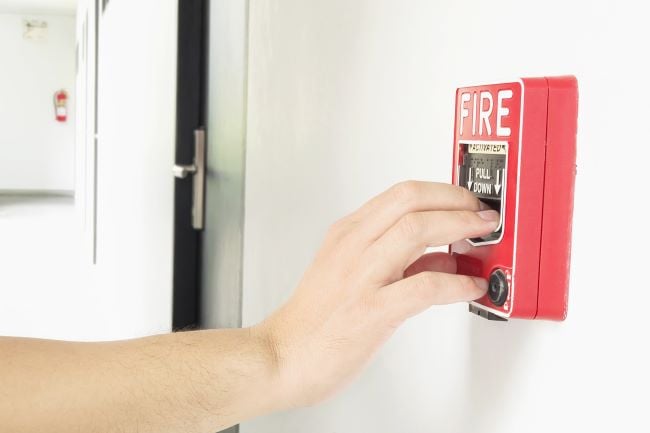Fire alarm manual pull stations are primarily located near building exits for easy access. These stations, usually red boxes mounted on walls, are manually activated components of a fire alarm system.
A fire alarm pull station is a crucial safety device, clearly labeled with instructions on how to activate them in the event of a fire emergency. The NFPA code mandates specific guidelines for the proper placement of these pull stations to ensure they are easily visible and accessible to building occupants.
Pull stations are strategically positioned along routes of travel within buildings to provide quick and efficient activation in case of a fire incident. Compliance with fire safety regulations requires proper installation and placement of these essential fire alarm devices.

Credit: www.quora.com
- Overview Of Fire Alarm Manual Pull Stations
- Importance Of Proper Placement
- Location Requirements For Fire Alarm Manual Pull Stations
- Understanding Fire Alarm Manual Pull Stations In Different Settings
- Best Practices For Installation And Maintenance
- Frequently Asked Questions For Fire Alarm Manual Pull Stations Are Primarily Located
- Conclusion
Overview Of Fire Alarm Manual Pull Stations
Fire Alarm Manual Pull Stations are essential components of any fire alarm system. These stations serve as crucial elements in initiating a manual fire alarm in the event of an emergency. Designed to be easily accessible, their strategic placement is of utmost importance in ensuring the safety of building occupants.
Definition Of Fire Alarm Manual Pull Stations
Fire Alarm Manual Pull Stations, also known as manual fire alarm boxes, are devices designed to be operated by individuals to initiate a fire alarm signal. These stations are usually identified by a prominent red box, clearly labeled with instructions on how to use them, and can be found mounted on walls.
Purpose Of Fire Alarm Manual Pull Stations
The primary purpose of Fire Alarm Manual Pull Stations is to enable individuals to manually alert others in the building of a fire or potential fire threat. These stations are strategically placed to ensure they are easily identifiable and accessible along routes of travel that would be used during an emergency evacuation.

Credit: www.hrw.org
Importance Of Proper Placement
Fire alarm manual pull stations play a crucial role in alerting individuals to emergencies and initiating a rapid response. Proper placement of these pull stations is essential to ensure their effectiveness in emergency situations.
Ensuring Accessibility
Placing manual pull stations in easily accessible locations is vital for ensuring that anyone can quickly activate them in case of a fire or other emergency. Pull stations should be strategically positioned along designated escape routes and near exits for swift access.
Enhancing Response Time
Strategic placement of fire alarm manual pull stations can significantly reduce response time during emergencies. By placing these stations in high-traffic areas and ensuring clear visibility, occupants can quickly locate and activate them, hastening evacuation procedures.
Location Requirements For Fire Alarm Manual Pull Stations
According to NFPA codes, fire alarm pull stations must be strategically placed to ensure quick access and visibility.
When determining the location of manual pull stations, building occupancy and usage should be taken into account to optimize safety measures.
Nfpa Code Requirements
Fire alarm pull stations must abide by NFPA codes to ensure they are appropriately located for accessibility and quick activation in case of emergency.
Building Occupancy Considerations
Considering the type of building and the occupants within it is crucial when deciding on the placement of manual pull stations to guarantee effective response during fire emergencies.
Understanding Fire Alarm Manual Pull Stations In Different Settings
Understanding Fire Alarm Manual Pull Stations in Different Settings
Commercial Buildings
In commercial buildings, fire alarm manual pull stations are strategically placed in easily accessible locations. These locations are typically near building exits, stairwells, and high-risk areas such as kitchens or mechanical rooms. This ensures that in the event of a fire, individuals can quickly locate and activate the fire alarm system, alerting occupants and initiating the evacuation process.
Residential Buildings
Similarly, in residential buildings, manual pull stations are positioned in key areas such as building lobbies, corridors, and near exits. Additionally, specific attention is given to areas with high occupancy, such as common living spaces and laundry rooms, to ensure that all residents have access to the pull stations in case of an emergency.
Healthcare Facilities
Healthcare facilities have specific guidelines for the placement of fire alarm manual pull stations to accommodate the unique needs of patients, staff, and visitors. Pull stations are strategically located in patient care areas, corridors, and near medical gas shutoff locations. This ensures that individuals with limited mobility or medical equipment can easily access the pull stations, contributing to a swift emergency response.
Best Practices For Installation And Maintenance
Proper installation and regular maintenance of fire alarm manual pull stations are crucial for ensuring the safety of occupants in any building. Adhering to best practices for installation and maintenance can help maximize the effectiveness of these devices in emergency situations. In this article, we will discuss two important aspects of installation and maintenance: height and visibility guidelines, and regular inspections and testing.
Height And Visibility Guidelines
When it comes to installing fire alarm manual pull stations, it is important to consider their height and visibility for easy accessibility. According to the National Fire Protection Association (NFPA) guidelines, pull stations should be positioned at a maximum height of 48 inches above the floor. This ensures that they are easily reachable by both standing and wheelchair-bound individuals.
Moreover, pull stations should be installed in highly visible locations, preferably near exits and along the routes of travel that would be used in case of an emergency. Placing them in well-lit areas with minimal obstruction improves their visibility and allows individuals to locate them quickly during critical situations.
Regular Inspections And Testing
Regular inspections and testing are essential to ensure that fire alarm manual pull stations are in proper working condition at all times. It is recommended to establish a routine inspection schedule and assign qualified personnel to inspect and test these devices.
The inspections should include checking for any physical damage or tampering and verifying that the operating instructions are legible and up to date. Additionally, periodic testing should be conducted to ensure that the pull stations activate the alarm system effectively and transmit the alarm signal to the designated monitoring station.
Here are some key points to consider:
- Inspect pull stations for physical damage or tampering regularly
- Verify that operating instructions on the pull stations are legible and up to date
- Conduct periodic tests to ensure the pull stations activate the alarm system
- Ensure the alarm signal is transmitted to the designated monitoring station
By adhering to these best practices for installation and maintenance, building owners and occupants can have peace of mind knowing that the fire alarm manual pull stations are properly installed, easily accessible, and in good working condition, ready to initiate a swift response in case of an emergency.

Credit: www.mdpi.com
Frequently Asked Questions For Fire Alarm Manual Pull Stations Are Primarily Located
Where Are The Manual Pull Fire Alarms Located?
Manual pull fire alarms are located primarily near exits and along routes of travel for easy accessibility in case of a fire emergency. They are typically red boxes mounted on walls and clearly labeled with instructions on how to use them.
Where Manual Fire Alarm Boxes Shall Be Located?
Manual fire alarm boxes should be located near exits and along routes of travel for easy access. They are typically mounted on walls and clearly labeled for use in case of fire emergencies.
What Is The Nfpa Code For A Manual Pull Station?
NFPA code for a manual pull station is NFPA 72. It is a manually activated component of a fire alarm system.
What Is A Fire Alarm Pull Station?
A fire alarm pull station is a manual component in fire alarm systems. It’s a red box on the wall with clear instructions for activation.
Where Are Manual Fire Alarm Boxes Usually Located?
Manual fire alarm boxes are typically located along routes of travel and near exits for easy access in case of an emergency.
Conclusion
The strategic placement of fire alarm manual pull stations is essential for quick responses in emergencies. Properly locating these red boxes along travel routes ensures occupant safety and aids in minimizing false alarms. Understanding the significance of their placement enhances overall fire safety measures.